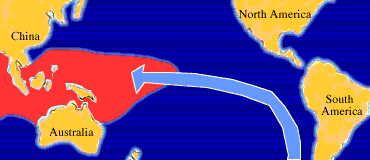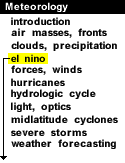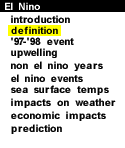
|
El Niño (Spanish name for the male child), initially referred to a weak, warm current appearing annually around Christmas time along the coast of Ecuador and Peru and lasting only a few weeks to a month or more. Every three to seven years, an El Niño event may last for many months, having significant economic and atmospheric consequences worldwide. During the past forty years, ten of these major El Niño events have been recorded, the worst of which occurred in 1997-1998. Previous to this, the El Niño event in 1982-1983 was the strongest. Some of the El Niño events have persisted more than one year.
| El Niño Years | |||
|---|---|---|---|
| 1902-1903 | 1905-1906 | 1911-1912 | 1914-1915 |
| 1918-1919 | 1923-1924 | 1925-1926 | 1930-1931 |
| 1932-1933 | 1939-1940 | 1941-1942 | 1951-1952 |
| 1953-1954 | 1957-1958 | 1965-1966 | 1969-1970 |
| 1972-1973 | 1976-1977 | 1982-1983 | 1986-1987 |
| 1991-1992 | 1994-1995 | 1997-1998 | |
Selected text from: CPC ENSO Main Page
In the tropical Pacific, trade winds generally drive the surface waters westward. The surface water becomes progressively warmer going westward because of its longer exposure to solar heating. El Niño is observed when the easterly trade winds weaken, allowing warmer waters of the western Pacific to migrate eastward and eventually reach the South American Coast (shown in orange). The cool nutrient-rich sea water normally found along the coast of Peru is replaced by warmer water depleted of nutrients, resulting in a dramatic reduction in marine fish and plant life.

Animation by: Shao
In contrast to El Niño, La Niña (female child) refers to an anomaly of unusually cold sea surface temperatures found in the eastern tropical Pacific. La Niña occurs roughly half as often as El Niño.
| La Niña Years | |||
|---|---|---|---|
| 1904-1905 | 1909-1910 | 1910-1911 | 1915-1916 |
| 1917-1918 | 1924-1925 | 1928-1929 | 1938-1939 |
| 1950-1951 | 1955-1956 | 1956-1957 | 1964-1965 |
| 1970-1971 | 1971-1972 | 1973-1974 | 1975-1976 |
| 1988-1989 | 1995-1996 | ||
Selected text from: CPC ENSO Main Page

introduction |
|

'97-'98 event |



